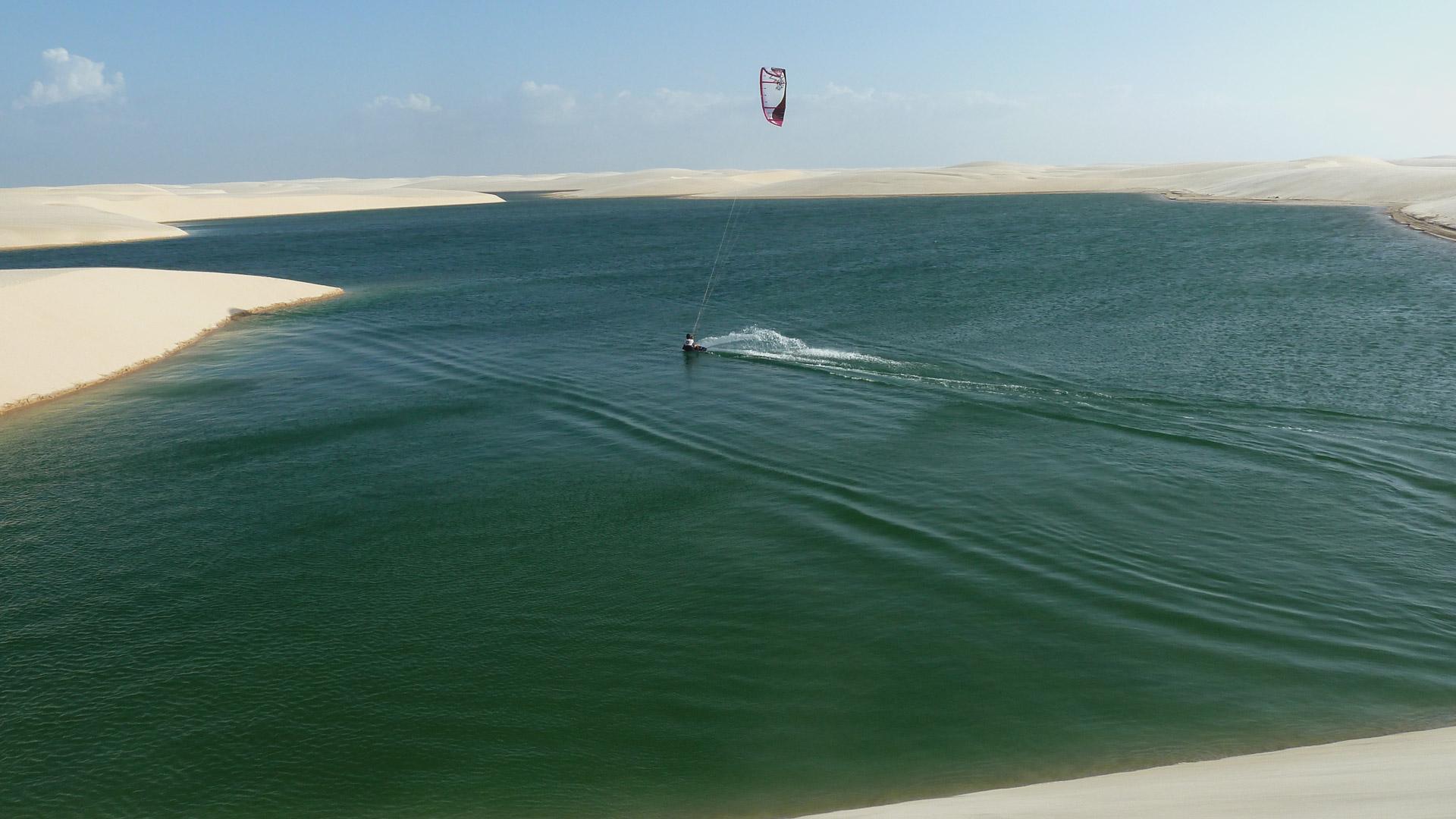Atins – The Stronghold of Kitesurfing in Brazil

Atins is a fishing village in Barreirinhas, Maranhão, built on the banks of the confluence with the sea, surrounded by dunes and crystal clear lagoons and the beauty of Lençóis Maranhenses. This village in northeastern Brazil has simple houses built on sandy roads on one side and an impressive expanse of dunes, lagoons, and sea on the other and is a real insider's tip for your Brazil trip. In recent years, this village has become the stronghold of kitesurfing, as it offers ideal conditions for this sport. In kitesurfing, also called kiteboarding, the athlete stands on a board that resembles a small surfboard, with which you can ride the waves. So if you want to know more about this insider tip and kitesurfing, read on!
History of Atins and of kitesurfing
Atins was a pure fishing village, separated from other larger villages by the dunes of the national park. Through the sport tourism of kitesurfing, the village has created more and more space for tourism without losing its rural character. Meanwhile, the village has gained a certain notoriety because of this and is very well known among kitesurfers. To better understand this relationship, the history of kitesurfing is important.
After first attempts in the 1820s, aviation pioneer Samuel Franklin Cody developed the man-carrying kite in 1903, connected it to a small sailboat, and crossed the English Channel with it. The development of aramid and high-strength polyethylene fibers in the late 1970s enabled the kite to triumph. These materials made it possible to produce stronger, more tear-resistant, and more effective cloth for the kites.
In the 1970s and early 1980s, German Dieter Strasilla developed a sail system that could be used to sail on land as well as in water and on snow. It also made jumping and flying or gliding possible. The brothers Bruno and Dominique Legaignoux developed inflatable stunt kites for kitesurfing in the early 1980s. These already looked almost exactly like today's tube kite and served as the starting model for all further developments.
After the success of the buggy kite starting in 1990, American Boeing aerodynamicist Bill Roeseler and his son Corey developed the KiteSki system with the idea of pulling a water ski with a two-line delta-shaped Tubekite. This was the first direct approach to kitesurfing. After some time the skis were replaced by a board. In addition, after further improvements and greater awareness, the first surf schools were now teaching kitesurfing. The first official competition took place in September 1998. To date, many competitions are held in different places around the world, which led to the fact that kitesurfing has now been included in the Olympic disciplines.
The tools of kitesurfing
The equipment consists at least of board, kite, bar with lines, harness, and the safety line. For tube kites also a pump to inflate the kite.
Currently, mainly twin tips and directional boards are used, as well as foil boards. The directional or directional board, also called surfboard or waveboard by some manufacturers, was adopted from surfing. The twin tip, also called twintip, was originally adopted from wakeboarding and can be ridden in both directions. The mutants are a mix of twin tip and directional board.
The liners are divided into 2, 4, and 5 liners. While the 4-liner allows for more maneuverability and dynamics, the 5-liner and the 2-liner offer more safety and stabilization. The 2-liner is especially beginner-friendly.
There are also different variants of the kite, which differ, among other things, in attack area and wind angle. The most important distinction is between softkites and tube kites. The softkites or ram-air kites look like paragliders and are mainly suitable for use on land, for example, snowboarding or all-terrain boarding. However, there are also softkites with closed cells that can be used for surfing on the water. Tubekites prevent the glider from sinking after a water landing, making it easier to launch in the water. Within the tubekites exist four subtypes.
Atins – Village of kitesurfing
Before the village of Atins established itself as a tourist destination, it was already popular among the followers of kitesurfing. One of the reasons why this village is considered one of the best places in Brazil for this sport is the strong and constant winds in the region.
Surrounded by the dunes of the Lençóis Maranhenses National Park, the estuary of the Rio Preguiças, a small feeder river called Igarapé, and the Atlantic coast lies Atins. Because of its secluded location, Atins is often called "the island".
When the tides are low, the kitesurfer has shallow, calm waters at his disposal, perfect for learning. Also, there is a channel that connects the Preguiças River with the sea, which is an attraction to enjoy big waves in the sea. However, the best time for kitesurfing is from July to December, when the winds get stronger.
Furthermore, the paradisiacal landscapes of the Lençóis Maranhenses region are ideal for hiking. As a destination for adventurous travelers, Atins is the ideal base camp to explore the famous Lençóis Maranhenses, as it has direct access to the national park and the sea.
Highlight for kitesurfers
All in all, the village of Atins in northeastern Brazil is a real insider tip for kitesurfers and travelers in general. With its simple and rustic style - there is limited internet reception and transportation - it has also kept its own identity as a simple fishing village. Despite this, there is an enormous amount to see, largely thanks to the national park. If you want to come back from your Brazil vacation with a special story and want to practice kitesurfing, there is no way around Atins!
Source: www.atins.me

